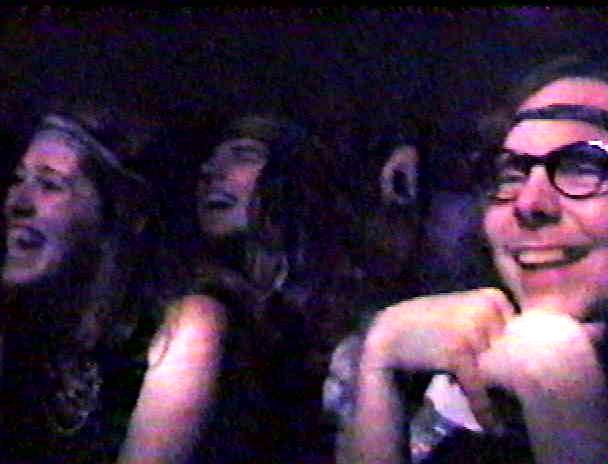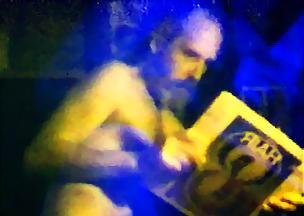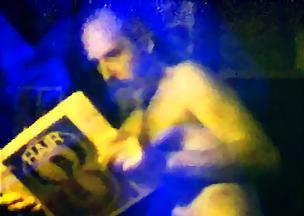


Some of The Willamette Tribe watching their fellow cast members on stage
---James Rado, the surviving co-author of HAiR, proved himself to be the personification of the spirit captured in the show. He generously gave hours of his time to confer with me via phone and fax to pass on his newest version of the script, which incorporated some things I asked permission to use from the "Paperback edition" of the script. It was an honor and an extreme pleasure to watch his creative mind at work first hand, and to have so many of his insights passed on to me.
---Inspiring a young cast to understand the sincerity and naivete of "the flower children" of the '60's was a particular challenge. Modern cynicism is a stumbling block I anticipated before rehearsals began, and was indeed encountered during the work.
---Building the show in such a way that the audience could admire the extended family The Tribe has created for themselves was my key concern. If the audience could truly love the group, then the message of "harmony and understanding" would be clear---despite any possible judgements some audience members might have about particular behavior of The Tribe.
---The psychedelic nature of the show's cinematic flow of scenes and the cumulative effect of recreating the era was critical in the choices made for technical elements and of staging the cascading succession of songs and scenes.
---The song "My Conviction," while an unusual "musical comedy" moment in the show, and one satirizing square outsiders trying to relate to the hippie movement, I found to carry a crucial underlying current in the show. This was the era when males began to free themselves of the unnatural restraints of "manliness" which had become the drab hallmark of 20th century masculinity. The strong love bond between Claude and Berger propels the plot, and is only possible in the context of this sub-culture which was pioneering in the male-liberation front. This guided me to choose a color palette for the costumes which kept the women primarily in earth tones, and added brighter and even gaudy colors on the men. They were the peacocks of the show, just as Margaret Meade sings about in her song.
---Multi-media was a new and experimental concept in live presentations of the '60's. Combining elements of "light shows" and other multi-media happenings of the time, I chose to have the set predominated with a 9' X 12' screen with images, both moving and still, rear projected as backdrops, commentary, and counter point to the action throughout. The screen was elevated 8' in the air and was upstage of the main action, and succeeded to not be a distraction but an integrated adjunct to the actors' performances.
---Keeping the sound of the musical performance from the band in the '60's style was paramount. The various updatings of HAiR's sound, such as that used in the late '70's film version were assiduously avoided, so that the original recordings were our guide in producing a sound not anachronistic to the era.
---Getting the audience in to the mindset of being back in the '60's was extremely important. Lobby decorations such as large photographs from the era, and a brief historical outline of the '60's in the program helped prepare the patrons.
What was most effective was having The Tribe interact with the audience as they arrived. Paper flowers were passed out, faces were painted, patrons were panhandled, incense was burned, and music was everywhere on the grounds of the theatre. The show's band, "The Electric Incense" sang and played songs of the era such as The Beatle's "Revolution" while Tribe members engaged in improvisational hand drum jams.
The drumming built to a height inside the auditorium, where The Tribe had the audience on its feet clapping as the drumming and chanting grew to a fever pitch. There was banging on oil drums and dervish-like dancing on the stage.
Then when the cast was given the signal that the House Manager was ready, The Tribe poured in to the aisles where they sat loudly shushing and staying boisterus even after the show officially began. It all worked wonders in starting HAiR with an audience who were not only warmed up but thoroughly with the concept that we were stepping back in time.
  |

|